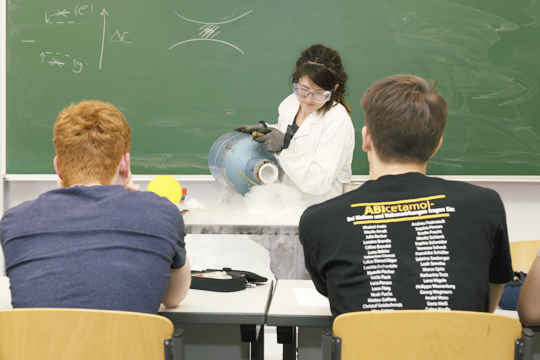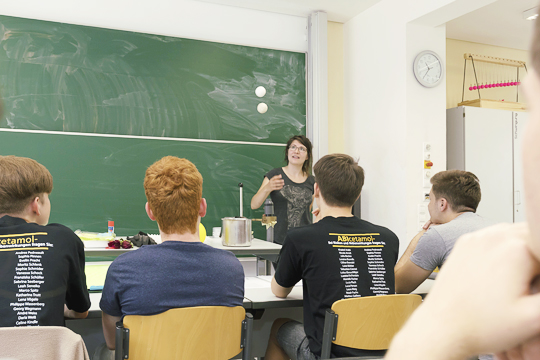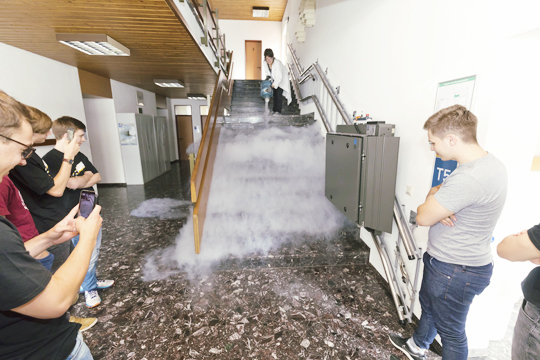Never fear! It’s Supposed to Be Smoking
Freiburg, Aug 01, 2018
University of Freiburg Master’s student Vivien Behrendt is giving secondary school pupils a look at what studying physics is all about. She’s letting them know about everything from syllabuses and exams to programming language and liquid nitrogen. Her introduction goes way beyond course content. She also tells them of the experiences and stumbling blocks one can encounter at the start of university studies. Then she shows them what happens in the lab.

Vivien Behrendt shows the effects of a liquid nitrogen bath on solids and gases. Photo: Jürgen Gocke
White fog billows down the stairwell. A group of laughing pupils film the scene with their cell phones. Vivien Behrendt is visiting the state secondary school in Ettenheim. The student of physics is showing the kids the experiments she’s working on for her Master’s thesis. It’s all about catching and researching atoms and molecules. Behrendt is studying Applied Physics at the University of Freiburg. She is in her fifth semester. At the moment she is working on her thesis and for the international research training group "Cold Controlled Ensembles in Physics and Chemistry," which includes Freiburg doctoral candidates and is researching the properties and dynamics of quanta.
Behrendt is currently on an assignment from the research training group. Her mission is to provide secondary school pupils with insights into the study of physics and what a physicist’s working day is like. Behrendt has designed a ninety-minute program that she’s been presenting in secondary schools in southwestern Baden-Württemberg. “I’m able in this way to tell pupils how hard it can be at the start of your studies,” Behrendt says. “That’s really important to me, because when I started studying I fell to the ground with a big thud,” she adds. The emphasis of her talk is on physics, but Behrendt explains there’s a great deal that it has in common with the other natural sciences and engineering and technology studies.

As if by magic, two balls float in the air – to illustrate a reaction between lithium and helium. Photo: Jürgen Gocke
Skills and career paths
Behrendt starts her presentation with her personal impressions from when she began studying at the university. Even when she was back in school, she loved technology and physics. It was clear to her then that she would go on to study natural sciences. But at the university, she first had to gain in depth knowledge of many topics that were only touched on in secondary school. All the new students simply had to grit their teeth and bear it. “You need to start working in groups early on,” she explains. The natural scientist from the University of Freiburg tells the youngsters about far more than the course of study, course content, and the knowledge required. She also presents possible career paths for physicists once they finish university.
Then it’s time for the first experiment. Using an app that works via smartphone sensors, Behrendt shows the kids how they can record the progress of a cardboard tube that’s rolling across the table. Data gathered about the speed of the cardboard tube are read out, shown on a laptop, and evaluated. “Recording and analyzing data is an important part of studying physics,” says the student. “Using an app and evaluating data with the help of programming language links school pupils’ routine with that of a physicist,” Behrendt elaborates.
The young physicist says she hasn’t wanted to teach up to now because research is far too much fun. Yet she also says she enjoys getting out of the lab now and then. Two girls and eleven boys are attending her presentation at the Ettenheim secondary school. She says, “I think it’s fantastic that at all the schools I have been to so far, the physics courses haven’t ever been males-only events.”

A fog rolls down the school stairway. Liquid nitrogen was a presentation highlight for the pupils. Photo: Jürgen Gocke
A rose, sponge, and an ink cartridge in the mist
The aspiring experimental physicist did work for her Bachelor’s thesis at CERN, a globally-known, major research facility in Geneva, Switzerland. For her Master’s degree, she’s investigating the cold reaction between lithium and helium. Now it’s time for experiment number two. To explain the basics of particle traps, Behrendt uses an airflow model to keep two balls floating in the air as if by magic. To be fair, she emphasizes that her daily routine isn’t always as exciting as it is in this class. She says, “You don't keep producing new results continuously. Most of the time, you’re working on fixing problems.”
The high-point of the event for the school pupils is the liquid nitrogen, which Behrendt uses to present certain aspects of low temperature physics and to explain the physical concept of cold. She shows them what a bath in liquid nitrogen does to solids and gases. The pupils are thrilled to submerge roses, a sponge, and an ink cartridge into the nitrogen fog and let them harden and shatter. The idea that they could be doing experiments like this more often themselves really seems to please them. That’s why Behrendt chose to conclude her talk by complying with a pupil's request to flood the school’s stairway with liquid nitrogen.
Annette Kollefrath-Persch

